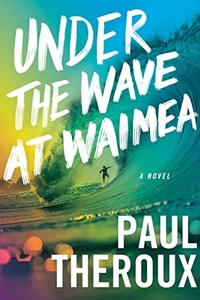
Published by Houghton Mifflin Harcourt on April 13, 2021
Paul Theroux’s new novel takes as its plot the life of a surfer. For a time, his life seems too superficial to sustain a plot. Joe Sharkey is a high school dropout, a stoner who — apart from a gig in his youth as a lifeguard — has never had a job. Millionaires envy Sharkey, “they wanted his friendship, they praised his life, the life he had made out of accident and desperation and dumb luck, his whole existence a form of escape, fleeing to the water to be himself and protecting himself on land by telling lies about his life.” Sharkey seems mindlessly happy, untroubled because he is disconnected from the ordinary concerns that plague the rest of us. How could such an empty life be interesting? In the literary hands of Theroux, anything is possible.
As the novel begins, Sharkey is 62, still surfing, but battling aches and doubts. He is a legend whose fame and skills are both diminishing. Theroux is 80 and, at least as a writer, has not diminished a bit. The story is about aging, but it is also about atonement and the search for meaning in life. In the novel’s last third, Sharkey’s mindless happiness has become mindful regret. There is more to life than happiness, Theroux reminds us. Under the Wave at Waimea suggest that true happiness can’t be attained without true understanding. “If I don’t know myself,” Sharkey asks near the novel’s end, “how can you possibly know me?”
The story is told in three parts. The first and last take place in Sharkey’s present. The middle of the novel constructs the details of Sharkey’s life. As an Army brat whose father wants him to go to West Point and serve in Vietnam, Sharkey gets kicked out of a private school for smoking weed and refusing to rat out his source. He’s ostracized as a haole in a public school but escapes the bullies by isolating himself on a surfboard. Over the years, building a life from sun and sea, Sharkey wins competitions, gets endorsement contracts, has sex with beach bunnies, and travels the world, never once reading a book or thinking that his life is missing anything worthwhile. He forms a superficial attachment to Hunter Thompson but never troubles himself to read the autographed copy of a book that Thompson gives him. Eventually Sharkey meets Olive, a kind and patient woman who loves Sharkey despite his faults, including his self-absorption, his unthinking failure to make her a meaningful part of his life.
The novel’s first part leads to its defining moment as a buzzed Sharkey, driving in the rain on a dark night while telling Olive a story from his past, hits and kills a homeless bicycle rider. Sharkey tells the cop who shows up that he hadn’t been drinking. The cop, recognizing Sharkey as a legendary surfer, doesn’t seem interested in investigating the death of a homeless man. When Olive presses Sharkey to discuss his role in the death, Sharkey dismisses it as inconsequential, but something about the death changes Sharkey, reduces him, makes him feel his age and steals his motivation to surf. Sharkey’s near drowning and Olive’s miscarriage send the message that a dark cloud is hanging over a life that Sharkey has always regarded as sunny and carefree.
The last part of the novel picks up the story of an unfocused Sharkey who is smoking too much weed and surfing too little, still refusing to acknowledge the importance of killing another human being. Tired of listening to Sharkey respond to her confrontation with “he was a homeless drunk,” Olive embarks on a quest to reconstruct the man’s life. He might have been a homeless drunk when he died, but she learns that he was much more than that during his life. Even in hard times, he was a trusted friend, an inspiration to those who knew him.
The quest takes Olive (with Sharkey in tow) to Arkansas and back to Hawaii, where they meet men who have fallen on hard times, including some Sharkey knew in his childhood. Olive forces Sharkey to add up his life, the life in which he feels so much pride, and stack it up against the remarkable highs and tragic lows of the life made by the man Sharkey dismisses as a “drunk homeless guy.”
Theroux is among the best painters of word pictures. From faces to fingernails, from rocky shores to moonglow on a distant headland that looks like “an outstretched paw,” Theroux’s descriptive prose invites visualization. Hawaii, of course, is a remarkable place to visualize. Theroux captures not just the beaches and waves but the beauty of a culture that values integrity and truth while practicing the ugliness of racial judgment. Sharkey believes that Hawaii’s beauty is pure, that everything ugly about the islands — drugs, shoes, plastic bags, crime scene tape — comes from the mainland. Sharkey only belatedly wonders whether he is part of the ugliness that has contaminated the native purity.
There is a lot to unpack in Under the Waves at Waimea. To some degree, the novel is about white privilege. Sharkey is a haole, scorned by many native Hawaiians until he proves himself as a surfer, but he gets endorsement contracts that better, native surfers never seek. Late in the novel Sharkey is accused of having “snobbed” his native peers. For the most part, the novel is about self-discovery, about the importance of kindness and the need to put aside self-satisfaction to live a truly happy life. But it is also about setting aside judgment, about recognizing the complexity and value of others, about not basing opinions on one sliver of a multi-faceted life. There is some redundancy in Theroux’s effort to make his points — there isn’t much subtlety here — but the points he makes are important and the story is both moving and memorable.
RECOMMENDED